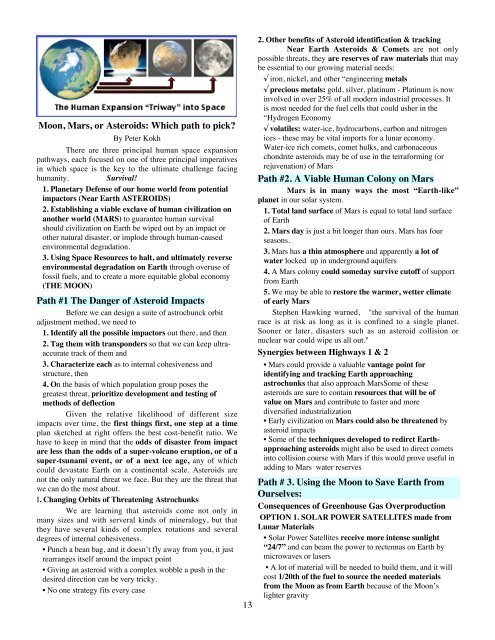Chandrayaan-1 Flies! Welcome to Moon Miners' Manifesto India ...
Chandrayaan-1 Flies! Welcome to Moon Miners' Manifesto India ...
Chandrayaan-1 Flies! Welcome to Moon Miners' Manifesto India ...
Create successful ePaper yourself
Turn your PDF publications into a flip-book with our unique Google optimized e-Paper software.
<strong>Moon</strong>, Mars, or Asteroids: Which path <strong>to</strong> pick<br />
By Peter Kokh<br />
There are three principal human space expansion<br />
pathways, each focused on one of three principal imperatives<br />
in which space is the key <strong>to</strong> the ultimate challenge facing<br />
humanity. Survival!<br />
1. Planetary Defense of our home world from potential<br />
impac<strong>to</strong>rs (Near Earth ASTEROIDS)<br />
2. Establishing a viable exclave of human civilization on<br />
another world (MARS) <strong>to</strong> guarantee human survival<br />
should civilization on Earth be wiped out by an impact or<br />
other natural disaster, or implode through human-caused<br />
environmental degradation.<br />
3. Using Space Resources <strong>to</strong> halt, and ultimately reverse<br />
environmental degradation on Earth through overuse of<br />
fossil fuels, and <strong>to</strong> create a more equitable global economy<br />
(THE MOON)<br />
Path #1 The Danger of Asteroid Impacts<br />
Before we can design a suite of astrochunck orbit<br />
adjustment method, we need <strong>to</strong><br />
1. Identify all the possible impac<strong>to</strong>rs out there, and then<br />
2. Tag them with transponders so that we can keep ultraaccurate<br />
track of them and<br />
3. Characterize each as <strong>to</strong> internal cohesiveness and<br />
structure, then<br />
4. On the basis of which population group poses the<br />
greatest threat, prioritize development and testing of<br />
methods of deflection<br />
Given the relative likelihood of different size<br />
impacts over time, the first things first, one step at a time<br />
plan sketched at right offers the best cost-benefit ratio. We<br />
have <strong>to</strong> keep in mind that the odds of disaster from impact<br />
are less than the odds of a super-volcano eruption, or of a<br />
super-tsunami event, or of a next ice age, any of which<br />
could devastate Earth on a continental scale. Asteroids are<br />
not the only natural threat we face. But they are the threat that<br />
we can do the most about.<br />
I. Changing Orbits of Threatening Astrochunks<br />
We are learning that asteroids come not only in<br />
many sizes and with serveral kinds of mineralogy, but that<br />
they have several kinds of complex rotations and several<br />
degrees of internal cohesiveness.<br />
• Punch a bean bag, and it doesn’t fly away from you, it just<br />
rearranges itself around the impact point<br />
• Giving an asteroid with a complex wobble a push in the<br />
desired direction can be very tricky.<br />
• No one strategy fits every case<br />
13<br />
2. Other benefits of Asteroid identification & tracking<br />
Near Earth Asteroids & Comets are not only<br />
possible threats, they are reserves of raw materials that may<br />
be essential <strong>to</strong> our growing material needs:<br />
√ iron, nickel, and other “engineering metals<br />
√ precious metals: gold, silver, platinum - Platinum is now<br />
involved in over 25% of all modern industrial processes. It<br />
is most needed for the fuel cells that could usher in the<br />
“Hydrogen Economy<br />
√ volatiles: water-ice, hydrocarbons, carbon and nitrogen<br />
ices - these may be vital imports for a lunar economy.<br />
Water-ice rich comets, comet hulks, and carbonaceous<br />
chondrite asteroids may be of use in the terraforming (or<br />
rejuvenation) of Mars<br />
Path #2. A Viable Human Colony on Mars<br />
Mars is in many ways the most “Earth-like”<br />
planet in our solar system.<br />
1. Total land surface of Mars is equal <strong>to</strong> <strong>to</strong>tal land surface<br />
of Earth<br />
2. Mars day is just a bit longer than ours. Mars has four<br />
seasons.<br />
3. Mars has a thin atmosphere and apparently a lot of<br />
water locked up in underground aquifers<br />
4. A Mars colony could someday survive cu<strong>to</strong>ff of support<br />
from Earth<br />
5. We may be able <strong>to</strong> res<strong>to</strong>re the warmer, wetter climate<br />
of early Mars<br />
Stephen Hawking warned, "the survival of the human<br />
race is at risk as long as it is confined <strong>to</strong> a single planet.<br />
Sooner or later, disasters such as an asteroid collision or<br />
nuclear war could wipe us all out."<br />
Synergies between Highways 1 & 2<br />
• Mars could provide a valuable vantage point for<br />
identifying and tracking Earth approaching<br />
astrochunks that also approach MarsSome of these<br />
asteroids are sure <strong>to</strong> contain resources that will be of<br />
value on Mars and contribute <strong>to</strong> faster and more<br />
diversified industrialization<br />
• Early civilization on Mars could also be threatened by<br />
asteroid impacts<br />
• Some of the techniques developed <strong>to</strong> redirct Earthapproaching<br />
asteroids might also be used <strong>to</strong> direct comets<br />
in<strong>to</strong> collision course with Mars if this would prove useful in<br />
adding <strong>to</strong> Mars water reserves<br />
Path # 3. Using the <strong>Moon</strong> <strong>to</strong> Save Earth from<br />
Ourselves:<br />
Consequences of Greenhouse Gas Overproduction<br />
OPTION 1. SOLAR POWER SATELLITES made from<br />
Lunar Materials<br />
• Solar Power Satellites receive more intense sunlight<br />
“24/7” and can beam the power <strong>to</strong> rectennas on Earth by<br />
microwaves or lasers<br />
• A lot of material will be needed <strong>to</strong> build them, and it will<br />
cost 1/20th of the fuel <strong>to</strong> source the needed materials<br />
from the <strong>Moon</strong> as from Earth because of the <strong>Moon</strong>’s<br />
lighter gravity















